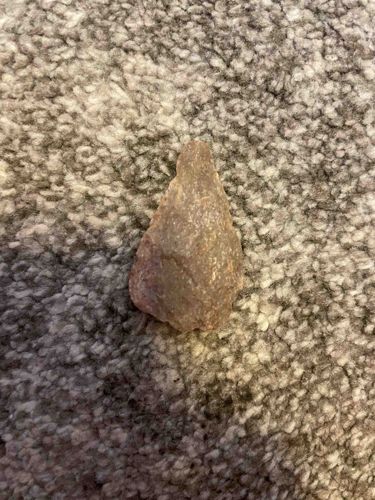
Stone Point/Projectile Point
This item appears to be a stone point, possibly a projectile point such as an arrowhead, spearhead, or knife blade, displaying characteristics of primitive stone tool craftsmanship. The material is a fine-grained stone, likely chert, flint, or quartzite, exhibiting a mottled grey to reddish-brown coloration with visible inclusions and a somewhat grainy texture. Its irregular, generally triangular shape tapers from a broader base to a sharper, though dulled, point. The edges show evidence of lithic reduction, with conchoidal fractures and flake scars indicating it was flaked or knapped into its present form. While not perfectly symmetrical, the shaping suggests intentional modification rather than a naturally occurring rock. The size cannot be precisely determined without a scale, but it appears hand-sized. There is no discernible hafting element or tang, suggesting it might be an earlier, cruder form, or a broken/unfinished piece. The surface shows a natural patination consistent with exposure and age, though there are no distinct maker's marks or signatures. The condition indicates wear and potentially some post-excavation damage or erosion of the edges and tip. It does not appear to have modern tool marks, suggesting an ancient origin, possibly from the Paleolithic, Mesolithic, or Neolithic periods, depending on further geological and archaeological analysis. The craftsmanship, while rudimentary, suggests a functional purpose.
AI-Generated Appraisal Disclaimer
Estimated Value
$75 - $150
Basic Information
Category
Archaeological Artifact
Appraised On
November 28, 2025
Estimated Value
$75 - $150
Item Description
This item appears to be a stone point, possibly a projectile point such as an arrowhead, spearhead, or knife blade, displaying characteristics of primitive stone tool craftsmanship. The material is a fine-grained stone, likely chert, flint, or quartzite, exhibiting a mottled grey to reddish-brown coloration with visible inclusions and a somewhat grainy texture. Its irregular, generally triangular shape tapers from a broader base to a sharper, though dulled, point. The edges show evidence of lithic reduction, with conchoidal fractures and flake scars indicating it was flaked or knapped into its present form. While not perfectly symmetrical, the shaping suggests intentional modification rather than a naturally occurring rock. The size cannot be precisely determined without a scale, but it appears hand-sized. There is no discernible hafting element or tang, suggesting it might be an earlier, cruder form, or a broken/unfinished piece. The surface shows a natural patination consistent with exposure and age, though there are no distinct maker's marks or signatures. The condition indicates wear and potentially some post-excavation damage or erosion of the edges and tip. It does not appear to have modern tool marks, suggesting an ancient origin, possibly from the Paleolithic, Mesolithic, or Neolithic periods, depending on further geological and archaeological analysis. The craftsmanship, while rudimentary, suggests a functional purpose.
Related Tags
Get Your Items Appraised
Instant estimates of your treasures with AI-powered instant appraisals